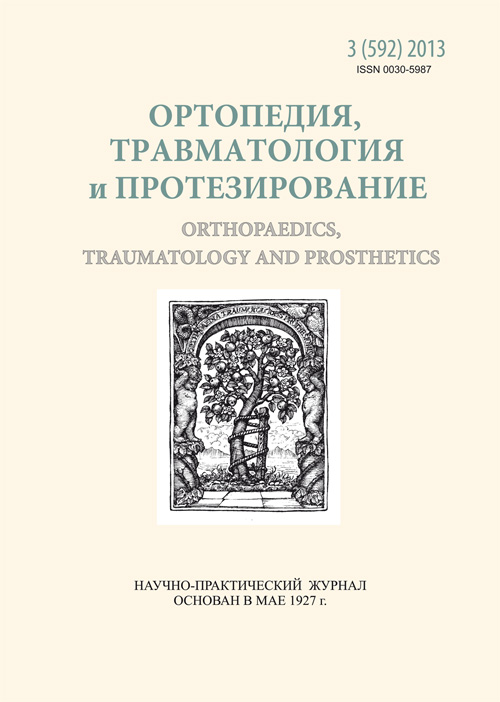Results of treatment of congenital hypoplasia of metatarsal bones by transosseous osteosynthesis after Ilizarov
DOI:
https://doi.org/10.15674/0030-5987201339-11Keywords:
brachimetatarsia, external fixation, AOFAS scaleAbstract
Brachymetatarsia is one of podiatric problems, which have been insufficiently covered in medical literature. Surgery is the main method for treating the above pathology. On the basis of the use of distraction technology according to Ilizarov the authors developed a method for lengthening the metatarsals. From 2006 to 2013, 34 female patients (53 feet) with brachymetatarsia were operated on. Long-term results of the treatment were evaluated by the AOFAS scale and achieved 89.2 ± 9.5 points. In all patients their lengthened segment was consolidated. The developed technique of transosseous osteosynthesis for brachymetatarsia made it possible to restore the length of metatarsals and weight-bearing capacity of the anterior foot in 80.6 % of cases. A partial loss of lengthening up to5 mmwithout any essential worsening of results was recorded in 5 patients. Thus, the suggested technique makes it possible to extend and supervise the direction of shortened metatarsals and is effective in treatment of brachymetatarsias.
References
- Actual X-ray anatomical parameters of the forefoot / A. A. Kardan, N. V. Zagorodnii, M. Р. Lukin, L. G. Makinyan // Journal of Radiology and radiology. — 2007. — № 3. — Р. 58–64.
- X-ray semiotics of congenital abnormalities of the stop / V. I. Shevtsov, G. R. Ismailov, G. V. Djachkov, T. E. Kozmina // Genius orthopedics. — 2000. — № 2. — Р. 38–41.
- Baek G. H. The treatment of congenital brachymetatarsia by one-stage lengthening / G. H. Baek, M. S. Chung // J. Bone Joint Surg. — 1998. — Vol. 80-B. — Р. 1040–1044.
- Bartolomei F. J. Surgical correction of Brachymetatarsia / F. J. Bartolomei // J. Am. Podiatr. Med. Assoc. — 1990. — Vol. 80 (2). — Р. 76–82.
- Complications of distraction osteogenesis in short fourth metatarsals / O. Chang-Wug, S. Rajan, S. Hae-Ryong et al. // J. Pediatr. Orthop. — 2003. — Vol. 23 (4). — Р. 484–487.
- The management of brachymetatarsia / H. T. Kim, S. H. Lee, C. I. Yoo et al. // J. Bone Joint Surg. — 2003. — Vol. 85. — Р. 683–690.
- How to avoid complications of distraction osteogenesis for first brachymetatarsia / K. B. Lee, H. K. Yang, J. Y. Chung et al. // Acta Orthop. — 2009. — Vol. 80. — Р. 220–225.
- Metatarsal lengthening by callotasis during the growth phase / B. Magnan, A. Bragantini, D. Regis, P. Bartolozzi // J. Bone Joint Surg. — 1995. — Vol. 77-B. — Р. 602–607.
- Lengthening of short great toes by callus distraction / Y. Takakura, Y. Tanaka, T. Fujii, S. Tamai // J. Bone Joint Surg. — 1997. — Vol. 79-B. — Р. 955–958.
- Metatarsal lengthening by callus distraction for brachymetatar¬sia / A. Wada, H. Bensahel, K. Takamura // J. Pediatr. Orthop. Br. — 2004. — Vol. 13. — Р. 206–210.
Downloads
How to Cite
Issue
Section
License
Copyright (c) 2014 Murod Saliev, Shaukat Ravshanov, Olim Djabborberganov, Zafar Kholov, Ilkhom Khujanazarov, Sanjar Kаdyrоv

This work is licensed under a Creative Commons Attribution 4.0 International License.
The authors retain the right of authorship of their manuscript and pass the journal the right of the first publication of this article, which automatically become available from the date of publication under the terms of Creative Commons Attribution License, which allows others to freely distribute the published manuscript with mandatory linking to authors of the original research and the first publication of this one in this journal.
Authors have the right to enter into a separate supplemental agreement on the additional non-exclusive distribution of manuscript in the form in which it was published by the journal (i.e. to put work in electronic storage of an institution or publish as a part of the book) while maintaining the reference to the first publication of the manuscript in this journal.
The editorial policy of the journal allows authors and encourages manuscript accommodation online (i.e. in storage of an institution or on the personal websites) as before submission of the manuscript to the editorial office, and during its editorial processing because it contributes to productive scientific discussion and positively affects the efficiency and dynamics of the published manuscript citation (see The Effect of Open Access).














